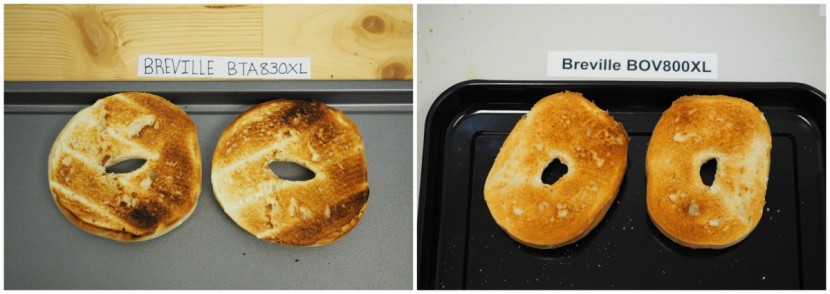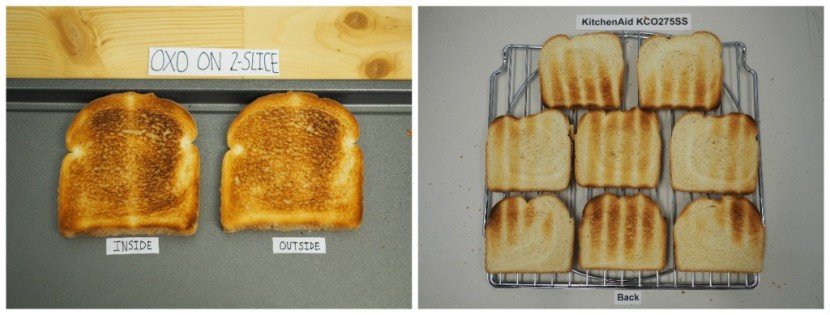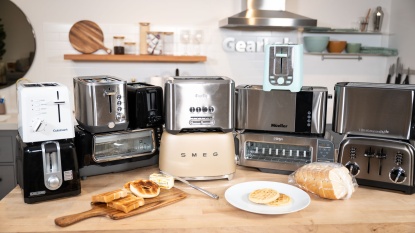How do you choose the best toaster oven? We bought the most highly regarded toaster ovens, ran them through a battery of tests, and ate an unhealthy amount of food, all so we could become experts on that very topic and help you make the right decision.
Toaster ovens are designed to be versatile kitchen appliances. In an ideal world, they would completely replace your toaster, microwave, and conventional oven. While this ideal model doesn't exist, we left our testing feeling that most models could handle 90% of the cooking and reheating done in the majority of households. In this article, we present the pros and cons of toaster ovens and layout a step-by-step guide for selecting the right product.
Why You Should Buy a Toaster Oven
Space Efficiency
Due to their versatility countertop ovens can offer a space-saving solution for many. Most people will find that they can replace both their microwave and traditional slot toaster with a toaster oven. Those living in small studios or student housing can easily use one of these for all of their cooking needs (with the exception of boiling water), negating the need for a conventional oven, toaster, and microwave.
Time Efficiency
Countertop ovens are much smaller than their conventional counterparts. Having less space to heat up means they can get to cooking temperature much faster than a conventional oven, often in half the time, which means there's less time between you and freshly baked cookies. Also, most countertops ovens have a convection feature that can speed up cooking times, but more on that later.
Energy Efficiency
Countertop ovens, again due to their smaller size, use less energy to stay hot than conventional ovens, often using as little as half the energy. This can result in significant energy savings if you constantly find yourself heating up your large conventional oven to make small meals or heat leftovers.
Better Leftovers
When reheated in a countertop oven, leftovers taste close to freshly cooked. You avoid all the sogginess that can result from heating food in a microwave. Sure, an oven takes longer to heat food than a microwave, but more often than not, it's worth the wait. Also, ovens can heat leftovers like muffins and cookies and make them taste close to freshly baked, while a microwave would struggle with reheating these types of baked goods.
Cheaper Convection
Convection ovens use fans to circulate warm air throughout the cooking space. This creates more even temperatures and thus more evenly cooked food. It also gets rid of excess humidity, allowing the outside of foods to brown more while retaining moisture on the inside. It can speed up cooking times as well. Conventional ovens with a convection feature tend to be quite expensive. Most toaster ovens offer convection cooking at a fraction of the price, which can be a huge draw if you're on a quest for the perfect cookie (and who wouldn't want to be on such a quest?). All of the models we tested, with the exception of the Panasonic FlashXpress include a convection feature. In our testing, we found that the convection modes in each model were equally effective, in that they all provided a boost to the quality of baking the ovens were able to produce without the convection mode switched on.
Better Bagels!
To our pleasant surprise, we found that toaster ovens generally make much better bagels than some of toasters (with some notable exceptions). In our testing, they were able to evenly toast the cut side of the bagel, an impressive feat given the inherent inconsistencies found on a sliced bagel. Also, most of the models we tested (the Panasonic FlashXpress being the one exception) had bagel modes that lowered the temperature of the bottom heating elements. This allows the backside of the bagel to get warm but remain untoasted, lending that incredible juxtaposition of crunchy and gooey that makes us all crave a bagel in the middle of a bothersome morning commute. This was nothing less than a miracle, as after we completed our toaster review we were really craving some top-notch bagels.
An Extra Oven for Big Kitchens
Those who tend to host dinners for large amounts of people can quickly run out of room in their conventional oven. In these cases, a toaster oven is a relatively cheap way to increase oven space. The countertop oven can handle side dishes, leaving the conventional oven free to focus on the main course. Also, countertop ovens are able to maintain much lower temperatures than conventional models. Many countertop models have a minimum setting of 150˚, while most conventional ovens bottom out at 350˚. This means a countertop oven can be used to keep foods warm without further cooking them. If you're making multiple sides that are ready at different times this keep warm function can be quite handy. Also, if you're trying to impress your guests and are making a dish that is ideally served at a very specific temperature these low-temperature settings can be used to warm plates. You wouldn't want to ruin your nice hot casserole by tossing it onto a cold plate, now would you?
Why You Shouldn't Buy a Toaster Oven
Decreased Capacity
The most obvious drawback to a countertop oven is its reduced capacity when compared to a conventional oven. While most countertop models can handle a 12-inch pizza, they can only accommodate a half batch of cookies or a single 8in x 8in pan. This makes it difficult to bake dinner for more than two people, requires multiple baking cycles to make a layer cake, and hampers your ability to go on late-night wine and cookie binges (though maybe that's a good thing).
Slightly Inferior Toast
Toaster ovens inevitably toast bread more inconsistently than traditional slot models because the side of the bread touching the rack toasts much differently than the opposite side. The majority of people probably won't even notice this, but if you're finicky about toast quality this may be a deal-breaker. These inconsistencies get worse the more bread you put in the oven at once. Ovens are inevitably hotter and thus toast bread better, in the center of the rack. So if you're trying to make toast for a large group and pack the oven full of bread, the slices towards the edges will be somewhat lighter than those at the center. Some models have a bigger toasting sweet spot, as we like to call it, than others, but all have this problem to some degree. For a much more in-depth discussion about toast quality, check out our best toaster review.
Microwave Meal Hardships
Countertop ovens can handle cooking microwave meals, but with some annoying additional steps. They must be transferred out of their plastic containers into an oven-safe dish. Microwave meal manufacturers generally don't include toaster oven instructions on the box, mostly because they don't want to be liable if someone melts the included plastic containers in an oven. So you'll have to do some trial and error to figure out how to get that frozen pad thai to come out perfectly. Finally, an oven will take much longer to cook these meals than a microwave.
Can't Heat Water
We know many people with smaller kitchens who use their microwave as a de facto kettle, popping in mugs full of water in order to make tea. This is a function that just can't be replicated in a toaster oven. It will handle your crumpets just fine, but you'll need another appliance to make the tea.
Choosing the Right Toaster Oven
If you made it through the pros and cons section thinking a toaster oven would be a good investment for you, our step-by-step guide will help you find the right model.
Step 1: How Much do You Care About Toast Quality?
Unfortunately, as we mentioned above, toaster ovens can't toast bread as evenly as a dedicated slot toaster. Most people won't be bothered by this, but if you're looking to make the smallest sacrifice in toasting quality possible you'll want to consider one of our top performers in that category. The Editors' Choice Award-winning Breville Smart Oven and the Top Pick for Convenience Panasonic FlashXpress shared the top score in our toasting test, each scoring an 8. Both can produce decent toast and our heat maps show that they each have a toasting sweet spot that can accommodate 4 slices of bread. The Breville makes toast a bit slower but is a more versatile machine overall. The Panasonic makes toast nearly as fast as a traditional slot model but is not as well-rounded a performer as the Breville. If you're not particularly fussy about your toast, then this won't factor into your decision.
Step 2: How Often do You Make Frozen Meals?
If you're a consistent frozen and/or microwave meal consumer and want to replace your microwave with a toaster oven, you'll most likely want to consider the Panasonic FlashXpress. Its dual infrared elements heat up instantaneously, negating the need for preheating. This greatly expedites the process of heating up leftovers and frozen meals. The Panasonic does have some drawbacks in terms of capacity (it can only accommodate a 9-inch pizza) and baking performance (it left cakes and cookies a bit scorched). All of the other models we tested make frozen meals significantly more slowly than the Panasonic, but all could also accommodate much larger dishes, and most produced much better results in our baking test. However, if your main concern making frozen meals quickly then the Panasonic is a clear choice.
Step 3: How Much do You Care About Baking Quality?
For some, the main reason to purchase a countertop oven will be to quickly bake small batches of desserts or meat. If baking will be your primary use we would recommend one of the top performers from our baking test. The Editors' Choice Award-winning Breville Smart Oven and the KitchenAid Countertop Oven were the two clear frontrunners in that test, both churning out excellent drumsticks and handling cakes and cookies with finesse. Coincidentally, these are also the two models that did the best in our temperature accuracy test. The Breville has the added bonus of being one of the top performers in our toasting test as well. If you're concerned about the baking quality and are on a budget our Best Buy Award-winning Black and Decker Countertop Convection Oven offers average baking performance for less than half the list price of the more expensive models.
Step 4: Consider Ease of Use
There is a reason we phrased the previous steps as, “How much do you care about…” rather than something more forceful, like, “You need to consider this.” It's because every model we tested can bake, toast, and make frozen meals. If you're especially discriminating about any one of those functions then you'd probably appreciate the subtle advantages of one of the top performers in that category, but every model can function in every capacity just fine. So if you're looking to purchase a countertop oven solely for the versatility aspect and don't have strong opinions on any specific mode of cooking, then ease of use is king.
Owing to their versatility toaster ovens have a myriad of modes, functions, and settings. Because of this models can separate themselves from the pack by simply presenting an intuitive way to navigate all of these options. Models like the Breville Smart Oven, which uses dedicated knobs to select the cooking mode, temperature, and duration make it quite easy to find your desired settings. Others can lead to a session of frustrated button mashing.
Can a Toaster Oven Replace Other Appliances?
Some of you may be looking towards a toaster oven as an option for replacing some other common kitchen appliances. We've summarized how well a toaster oven can replace those appliances below.
Can it Replace a Traditional Slot Toaster?
The vast majority of people will be perfectly satisfied with the toast that comes out of a toaster oven, though they do have some drawbacks when compared to traditional slot models. On the medium setting, it will take about 2-3 minutes to make toast in a traditional slot model, while the time doubles to 5-6 minutes in an oven. The wire racks in ovens tend to leave streak marks in toast, and toast placed towards the exterior tends to toast lighter than toast placed in the middle. This means that, in general, ovens don't toast bread as evenly as traditional slot models. However, these minor inconsistencies will only matter to those who are very particular about their toast. If you're one of those people, you'll want to take a look at our toaster review.
One area where ovens blow traditional slot models out of the water is bagels. We struggled to find a traditional slot model that could adequately satisfy our craving for cream cheese topped crunchy and gooey goodness. However, every oven we tested was able to at least approach coffee shop level perfection.
Can it Replace a Microwave?
From a quality and taste perspective, we feel that toaster ovens clearly best microwaves in reheating leftovers. Food reheated in an oven has an almost freshly made quality to it, while microwaves can often leave leftovers half soggy and half scorched. Of course, microwaves can heat food much faster, so you'll have to be a bit more patient to get the superior results an oven offers. Also, microwaves can heat liquids while an oven would struggle in this capacity, and microwave meals require additional steps to be made in an oven. For more information on this topic see your buying advice article.
The model we tested that is most analogous to a microwave is the Panasonic FlashXpress, our Top Pick for Convenience. It uses a unique double infrared heating technology that nearly eliminates pre-heating time, making it functionally feel like a microwave. We found that this intense method of heating, along with its small size, limited both the baking performance and versatility of the FlashXpress. However, it is the closest thing you'll find to a microwave that can also make toast. Just remember not to stare at it too long, the manual states that long-term eye exposure to its speedy heating elements that glow like the rising sun could be damaging.
Can it Match the Results of a Conventional Oven?
This is where toaster ovens really shine. Except for the limitations of the Panasonic FlashXpress, listed above, we found in our testing that most countertop models can bake everything from desserts to meats just as well as their conventional oven counterparts, with the obvious caveat of a reduced capacity. As an added bonus, they can do so with quicker preheat times while using half the energy of a conventional model. The only area where we feel a conventional oven clearly outperforms a countertop model is in broiling performance. All of the models in this review produced mediocre broiling results. The Panasonic FlashXpress, which doesn't have a broiling function, was the worst of the bunch.
Conclusion
In general, all toaster ovens provide similar functionality, and spending a bit more will get you increases in baking and toasting performance, better temperature accuracy, and a more friendly user interface. The big exception to this rule is the Panasonic FlashXpress. While for all intents and purposes it is a toaster oven, its size and features make it function more like a traditional slot toaster and microwave hybrid.













